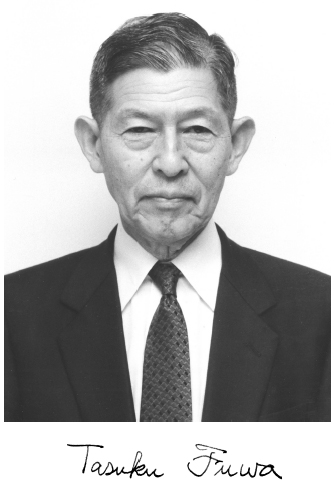
1915–2013
Elected in 1979
“For contributions in the field of metallurgy and leadership in the profession.”
BY MERTON FLEMINGS
TASUKU FUWA, professor, Tohoku University, and executive advisor, Nippon Steel Company, died on November 23, 2013 at the age of 98. He was an international leader in the physical chemistry of molten iron, steel and slags. He was the first Japanese elected to membership in the National Academy of Engineering.
Professor Fuwa was born in Kumamoto Prefecture as the fifth of six children. His family stems from the upper-class Hosokawa clan. He went to Higher School No. 5 in Kumamoto, where he began medical studies, with German as his first foreign language.
Although his father died when he was ten years old, all six children were able to attend university through the support of the Hosokawa family. Fuwa attended Tohoku Imperial University, receiving his undergraduate degree from the Department of Metallurgy, Faculty of Engineering, in December 1941. He entered graduate school at Tohoku in 1942 and became research associate, special research scholar, lecturer, and then assistant professor in 1946.
In 1954 Professor Fuwa was sent by his university to MIT, where he studied under John Chipman until 1957, receiving his doctorate in 1958. After retuning to Tohoku he was promoted
________
* With assistance from two distinguished Japanese Metallurgists, Professor T. Koseki and Dr. T. Matsumiya, and through them from Professor Fuwa’s daughter, Mrs. Hikari Takuma.
to professor in 1962 and remained at the university until he retired in 1979, when he joined Nippon Steel Corporation as executive advisor.
Professor Fuwa was elected a Fellow of the American Institute of Mining, Metallurgical, and Petroleum Engineers (AIME) in 1974. He was awarded the Nishiyama Medal of the Iron and Steel Institute of Japan in 1976. He was president of the Japan Institute of Metals in 1979–1980. He became Honorary Member of both the Japan Institute of Metals and the Japan Iron and Steel Institute in 1982, and a Distinguished Member of AIME in 1984, when he also received the Honda Memorial Prize. He was elected the first Japanese member of the Chinese Academy of Engineering in 1996. In 1997 he was awarded the Gold Medal of the Japan Institute of Metals, and in 1995 the Tawara Gold Medal of the Iron and Steel Institute of Japan.
In 1974 Fuwa led the establishment and initiation of the Matoba Memorial Kawatabi Seminar on Iron and Steelmaking for researchers and engineers in industries and universities. This seminar continues to be held once a year—the 39th seminar was held in 2013—and has contributed much to the development of the steel industry in Japan.
At Nippon Steel Corporation, he attended all internal company symposia of researchers and engineers on steelmaking, with insightful comments and advice. He visited steelworks and advised on technical aspects of their operation. He also advised and arranged the foreign studies of many young researchers and engineers at Nippon Steel and wrote recommendation letters to the appropriate universities. One of many specific technical contributions was his leadership, with Jin-ichi Takamura, of a project on oxide metallurgy that resulted in important advances in steelmaking technology. Under Professor Fuwa’s guidance, many researchers and engineers were both educated in their professions and inspired to follow his example.
Professor Fuwa had many friends and acquaintances throughout the world, all of whom enjoyed his warm company and good humor, and respected his accomplishments and commitment to his profession.




